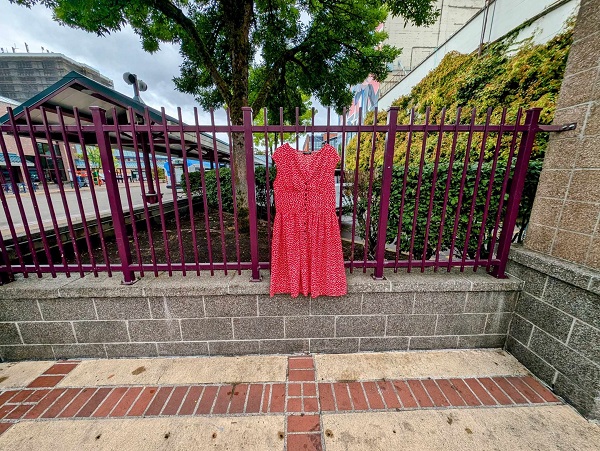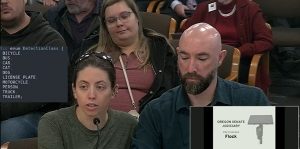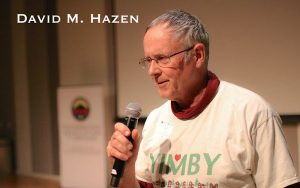Beyond the red dress: The impact of Missing and Murdered Indigenous Women in Oregon
5 min read
|
Getting your Trinity Audio player ready...
|
by Sarah Koski
In 2019, while working as a development coordinator for Volunteers in Medicine, I frequently attended events and lectures at the University of Oregon. Each day, I would browse the University calendar to supplement my continuing education on the days I didn’t attend Bible studies. One particular event had a profound impact on me.
On a cold, late evening, I made my way from the eighth floor of the downtown Eugene PeaceHealth hospital to a set of dorms near the Knight Law Center. Due to a mild storm that slowed my pace, I arrived late and had to be buzzed into the conference room.
Before entering, I noticed rows of red dresses hanging from the walls in the hallway leading to the event space. I quietly entered the room, where I was the only member of the outside community among dozens of young faces listening to a panel of Indigenous teachers and students discussing the Red Dress Project and Missing and Murdered Indigenous Women (MMIW).
After the lecture, I was warmly greeted by several young Honors College undergrads adorned with beautiful beads and smiling faces. Although I initially intended to leave directly after the event, I changed my mind after learning more about their vision for the local red dress initiative. As I listened to these young women share their perspectives, it became clear to me how limited my understanding was regarding local tribal relations and the #MMIW crisis.
Despite attending numerous anti-trafficking events, meeting with task force leaders across the state, and developing campaigns for projects both locally and globally, I had never encountered the alarming statistics of tribal assaults and deaths. This realization highlighted a significant gap in my knowledge — and after connecting with these young women, I vowed to address it moving forward.
The alarming statistics
Here’s the reality.
In Oregon, Native women face disproportionately high rates of violence, trafficking, and exploitation, yet the lack of accurate data and systemic failures leave these women especially vulnerable. Over four in five American Indian and Alaska Native women (84.3%) have experienced violence in their lifetime. More than half (56.1%) have faced sexual violence, and 55.5% have endured physical violence by an intimate partner. Stalking affects 48.4%, and 66.4% have suffered psychological aggression from a partner, according to a 2016 National Institute of Justice study.
Murder is the third leading cause of death for Native women. In Oregon, the missing persons database recorded 26 Native women missing in 2017, aged between 14 and 29. Yet, these figures only scratch the surface, as underreporting by both victims and law enforcement obscures the full scale of the crisis. Recording victims’ race is often inconsistent, especially in databases from agencies like the Oregon State Police, Multnomah County Sheriff’s Office, and Portland Police Bureau.
The connection between #MMIW and human trafficking
The numbers paint a stark picture. Trafficking is a significant factor in the violence Indigenous women face, particularly along transportation corridors like Oregon’s I-5. Native women, both from Oregon and other states, are trafficked through this corridor, which serves as a major hub for exploitation. In Madras, outside the Warm Springs Reservation, traffickers have been reported picking up young women and transporting them to Portland, a city known to be an epicenter of sexual deviancy and sex-related crimes.
Unfortunately, human services organizations and law enforcement agencies often do not track the percentage of Native American women among trafficking survivors, even though they collect such data for other ethnicities. This lack of specificity further obscures the full scope of the problem.
Recent case highlights continued struggles
Just recently, Oregon Public Broadcasting reported on the case of Wilma Acosta, a Pascua Yaqui woman who went missing in Portland in November 2023. Her body was discovered in the Willamette River in January 2024. While Portland Police ruled her death a suicide, Acosta’s family definitively disputed this conclusion, raising concerns about how the case was handled. This situation highlights what so many in tribal regions face every day.
In May 2024, while attending the Oregon Commission for Women’s Missing and Murdered Indigenous Women Lunch and Learn, a panelist asked every Indigenous woman present to raise their hand if their family or someone close to them had gone missing or disappeared. Every hand raised in the room. Again, I realized my scope was too narrow. Reading about statistics, attending events, and browsing articles was not enough.
Legal and jurisdictional gaps
The history of violence against Indigenous women is deeply tied to legal and jurisdictional challenges. Tribes have historically lacked the ability to prosecute non-Native offenders who commit crimes on tribal lands. Although the 2013 reauthorization of the Violence Against Women Act granted tribes more jurisdiction in prosecuting some non-Native crimes, many gaps remain.
In Oregon, state authorities have jurisdiction over crimes committed by non-Natives in most areas, except for a few reservations like Umatilla, Warm Springs, and Burns Paiute. The Umatilla tribe, however, now has federal jurisdiction to prosecute non-Natives for certain crimes. Even so, enforcement can still be inconsistent, leaving Native women vulnerable.
Efforts to raise awareness and seek justice
There are ongoing efforts to raise awareness about MMIW at both local and national levels.
At the federal level, legislation like Savannah’s Act, introduced in 2017, aimed to improve data collection and law enforcement protocols in MMIW cases and was finally signed into law in 2020. The bill requires the Department of Justice to update federal databases to include tribal affiliation of victims and develop standardized investigative protocols.
This August, the federal government enacted the Missing and Endangered Indigenous Persons (MEP) Alert System, a critical tool designed to address disparities in how missing Indigenous people are located. The new nationwide alert code, similar to Amber and Silver Alerts, aims to help locate Indigenous individuals who may not meet the criteria for these existing systems.
Finally, the U.S. Senate designated May 5th as the National Day of Awareness for Missing and Murdered Native Women and Girls. Lawmakers, including Oregon Sen. Ron Wyden, continue to push for further recognition and action through ongoing resolutions.
While these advances are crucial, raising public awareness remains essential to drive meaningful change and address the ongoing crisis of missing and murdered Indigenous women.
What can be done?
The crisis of Missing and Murdered Indigenous Women is multifaceted, requiring collaboration across communities, law enforcement, and policymakers. Improved data collection, better training for law enforcement, and increased resources for Native women are all critical steps in addressing this epidemic.
For transit professionals, there is also a role to play. Public transportation systems, like Lane Transit District (LTD), can be critical in both identifying trafficking and ensuring the safety of vulnerable populations. Transit workers can be trained to recognize signs of trafficking and work with local law enforcement to disrupt these operations.
The first step, however, is raising awareness. The more people who understand the scope of the problem, the harder it becomes for these cases to be ignored. Native women have been waiting for justice for far too long—it’s time to listen, learn, and act.
Sarah Koski serves as Homelessness and Community Resource Liaison for the Lane Transit District. Read, subscribe, and donate at https://sarahcascadia.substack.com/.






